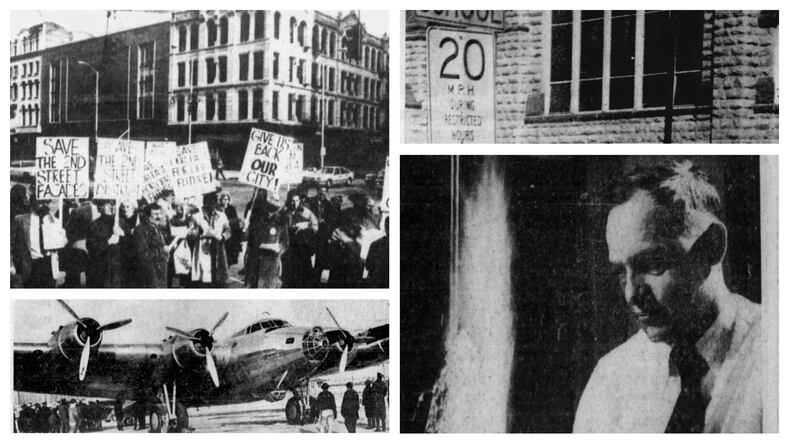Here’s a look at some stories happening the week of Dec. 10-16.
Dec. 12, 1937: World’s largest bomber at Wright Field for tests
The world’s biggest military aircraft, the XB-15, arrived in Dayton to “undergo intensive testing operations” in Dayton.
The airplane, which had arrived from Seattle, was described as having a “sleek, silvery body glistening in the sunlight.”
The plane had four 1,000-horsepower twin-row Pratt and Whitney “Wasp” engines and flew with a crew of nine. For some reason there were also two guinea pigs on the plane serving as mascots for its maiden voyage.
The new “Mastodon of the skies” weighed 30 tons and was 90 feet in length, and the wingspan was 145 feet.
Dec. 16, 1951: Fire prevention aids in halting Christmas tragedies
The Dayton Fire Department was trying to save lives in 1951 through Christmas tree fire prevention.
Fire inspectors began early in the season, testing trees that were to be used in public buildings. Under Ohio law, all Christmas trees and decorations for public buildings had to be flame-proofed chemically.
Samples were collected and taken to the fire prevention laboratory. If decorations, when subjected to a flame, caught fire but the flames did not spread, it was a point in their favor. Then the afterglow of the flame could last no more than 15 seconds to be approved.
One of the main decorations that caused concern was “tinsel.” Many tinsels were found to be highly combustible and were sometimes removed from story shelves and banned from sale.
Tree samples were baked for an hour at 140 degrees and their moisture loss was noted by weighing.
After being set up in a store or building, trees and decorations were tested as much as once a day, a drop below standards could mean removal.
Firemen were stationed in stores to spot hazards and maintain safety. They also inspected schools, churches, theaters and other public gathering places.
Dec. 10, 1962: Speed limit signs catching on
Drivers were not yet fully accustomed to reading speed limit signs in 1962, but drivers were starting to pay more attention to them. And also complain about them.
Many drivers were confused about how a speed limit for a certain area was determined.
Speed limits were determined by state law, but during this time, it was common for driver complaints to be heard and for speed limits to be changed or bypassed by individual cities.
Most city roads were 35 mph except for school zones, which were 20 mph.
Highway speed was 65 mph. However, one of the biggest concerns was the need for minimum speeds to be posted on highways and the confusion it caused.
The Dayton traffic engineer at the time said, “As city people become familiar with the operation of freeways they become just as concerned over the slow driver as the fast driver.”
“Restricted hours” in school zones were also confusing to some drivers. Traffic engineers agreed it was best to play it safe and slow down in the school zones from early morning until late afternoon.
The latest innovation for school zones were flashing yellow signs with a red “20″ which lit up during restricted hours, which aimed at putting an end to the confusion.
Dec. 10, 1976: 15,000 workers on strike at 3 Dayton GM divisions
Negotiations between officials of the International Union of Electrical Workers and General Motors Corp. continued while 15,000 employees at three GM plants went on strike this day.
The local divisions affected by the strike were Frigidaire, Delco Air Conditioning and Delco Products.
The contract with GM originally expired Sept. 14. However, it was extended repeatedly until a midnight deadline was reached.
Unresolved demands for reduced work time, improved health care benefits and equal opportunity provisions were listed as stumbling blocks during negotiations.
Picketing at the plants was peaceful. At Delco Products in Kettering, it was reported that no members were trying to cross the picket lines.
Workers returned to their jobs for the afternoon and evening shifts later that same day after the conclusion of a 25-hour bargaining session.
Dec. 11, 1987: Preservationists try to beat the clock
Supporters of the Second Street Historic District were protesting the pending demolition of historic facades they hoped to save.
With a wrecking crew in the background, demolishing the façade of the 19th century building that had most recently housed the Mill End Drapery Galleries at 118 N. Main St.
The demolition was making way for Citizens Federal Centre, a 20-story, $45 million project.
The building the group most wanted to save was the Cooper Building, an ornate, four-story structure built in 1878 at the corner of East Second and North Main Streets.
The Cooper building facade was stored and then laster incorporated into the RTA Wright Stop Plaza along east Third St.
The Citizens Federal Centre building later became known as Fifth Third Center. In 2011, Premier Health Partners acquired the building.
About the Author






